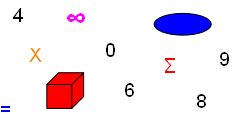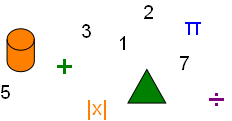



Simplifying Radical Expressions


Simplifying Radical Multiplication
By applying math operations on radicals we can convert expressions to fractional exponent notation, perform operations with exponents and convert the answer back to radical form. Two math rules make it easier to work with radical multiplication and are consistent with the rules of exponents:
Rule 1
n√an = (an)1/n =
an/n = a1 = a
Rule 2
n√a × n√b = n√(ab)
(nth root of a non-negative number is the number)
Radical Multiplication without variable terms:
4√164 = 16
√8 × √18 = √144 = 12
Radical Multiplication with variable terms:
√(6x3y) × √(3xy) = √(18x4y2) = √(3 × 3 × 2 × x2 × x2 × y2) = 3x2y√2
With x = 2, y = 3; decimal answer is 50.91
Math Tip: Always work one same base term set at a time, then the next same base term; number terms, then “x” terms, then “y” terms, and so forth.
Simplifying Radical Division
Radical Division without fractional exponents:
n√a / n√b = n√(a/b)
3√32 / 3√4 = 3√(32/4) = 3√8 = 2
(18 − √180) / 9 =
(18 − √(5 × 3 × 3 × 2 × 2)) / 9 =
(18 − (2 × 3)√5) / 9 =
(18 − 6√5) / 9 =
(6 − 2√5) / 3
Always work obvious math first.
√(5x3w) / √(4xw2) =
Place obvious square roots of squares in front of their radical:
x√(5xw) / 2w√x =
Reduce same base variables in numerator and denominator by subtracting their exponent index, x is under a radical of the numerator and of the denominator, therefore x1−1 = x0 = 1
x√(5 × 1 × w) / 2w =
x√(5w) / 2w
Eliminating the denominator radical rationalizes the denominator. This simplifies math and reduces complexity.
Radical Division with fractional exponents:
n√a / n√b = a1/n / b1/n = (a/b)1/n
and,
n√am / n√bm = n√(am/bm) = n√(a/b)m = (a/b)m/n
√5 / √2 =
If there is a radical or exponent in the denominator. It is difficult to divide a decimal by a decimal. The result of 2.2361 / 1.4142 is 1.5811.
We can apply a math trick to remove the radical from the denominator: Multiply the numerator and the denominator by the quantity of the denominator making the denominator a perfect square.
(√5 × √2) / (√2 × √2) = √10 / √4 = √(10) / 2 =
3.1622 / 2 = 1.5811
√(m2x) / √(mx2) =
Remove obvious squares from radicals.
m√x / x√m =
Rationalize the denominator by eliminating the radical from the denominator.
m√(xm) / x√(mm) = m√(xm) / xm =
m is not inside a radical of either the numerator or denominator, m / m = 1; m can be removed.
√(xm) / x
The math problem could also be worked as follows:
√(m2x) / √(mx2) =
√(m2−1 × x1−2) =
√(m1 × x−1) =
√m / √x =
Rationalize the denominator.
√(mx) / √(xx) = √(mx) / x
Copyright © DigitMath.com
All Rights Reserved.